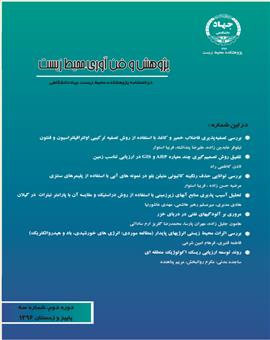بررسی توانایی حذف رنگینه کاتیونی متیلن بلو در نمونههای آبی با استفاده از پلیمرهای سنتزی
محورهای موضوعی : تکنولوژی آب و فاضلاب
مرضیه حسن زاده
1
,
فریبا استوار
2
![]()
1 - دانشگاه گیلان
2 - پژوهشکده محیط زیست جهاددانشگاهی
کلید واژه: پلی پیرول جذب سطحی پلی 3- متیل تیوفنجاذب اصلاح شده با سورفاکتانتایزوترم,
چکیده مقاله :
در این پژوهش، بررسی توانایی حذف رنگینه کاتیونی متیلن بلو با استفاده از پلیمرهای الكترواكتيو بر پایه پلی پیرول (PPy)، و پلی (3- متیل تیوفن) (P3MTh) در سيستم ناپیوسته مورد مطالعه قرار گرفت. از خاک اره (SD) تهيه شده از چوب نراد پس از مش بندي به عنوان نگه دارنده جهت پوشش پليمرها و از سورفاکتانت آنیونی سدیم دودسیل سولفات (SDS) برای اصلاح سطح خاک اره پوشش داده شده استفاده شد. اثر برخی پارامترهای مهم مانند pH، غلظت اولیه رنگینه و زمان تماس بررسی شدند. برای ارزیابی داده هاي بهدست آمده، از منحنی های ایزوترم جذب (لانگمویر و فروندلیچ) استفاده شد. راندمان جذب برای متیلن بلو در pHهای بازی به حداکثر رسید. ظرفیت جذب با افزایش غلظت اولیه و زمان تماس افزایش یافت. در تمام موارد فرایند جذب از ایزوترم لانگمویر تبعیت ببشتری میکند و نشاندهنده فرآیند همگن و تک لایه می باشد. همچنین ظرفیت جذب بدست آمده در پلیمرهای SD/PPy، SD/PPy/SDS و SD/P3MTh به ترتیب برابر 52/59، 400 وmg/g 1000 شد. براساس بررسیها و نتایج حاصله در این پژوهش، مشاهده گردید که این مواد پلیمری میتوانند بطور مؤثری در رنگبری پسابهایی نظیر صنایع نساجی بکار گرفته شوند، که از نظر زیست محیطی از اهمیت ویژه ای برخوردار میباشد.
In this research, the ability for removal of methylene blue cationic dye using Electro active polymers based on polypyrrole (PPy) and poly (3-methylthiophene) (P3MTh) in a batch system were studied. Sawdust (SD) was made from wood, after patching, as a holder for coating polymers and Sodium Dodecyl Sulfate Anionic Surfactant (SDS) was used to modify the surface of the sawdust. The effects of some important parameters such as pH, initial concentration of dye and contact time were investigated. To evaluate the obtained data, adsorption isotherm curves (Langmuir and Freundlich) were used. The adsorption efficiency for methylene blue was maximized at alkaline pH. Adsorption capacity increased with increasing initial concentration and contact time. In all cases, the adsorption process complies with Langmuir isotherm and represents the homogeneous and single-layer process. Also, the adsorption capacity obtained in SD/PPy, SD /PPy / SDS and SD / P3MTh polymers were 59/52, 400 and 1000 mg/g, respectively. Based on the studies and the results obtained in this study, it was found that these polymer materials can effectively be used in waste dyes, such as textile industry, which they have the great environmental significance.


